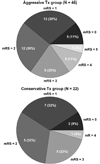Aggressive care after a massive stroke in young patients: is that what they want?
- PMID: 20182921
- PMCID: PMC2897961
- DOI: 10.1007/s12028-010-9340-7
Aggressive care after a massive stroke in young patients: is that what they want?
Abstract
Background: The assumption is often made that aggressive care in the form of early decompressive hemicraniectomy is appropriate for young patients who suffer a massive stroke. However, neither their attitude toward aggressive treatment, nor their perception of acceptable quality of life after a stroke, has been adequately studied.
Methods: We conducted a cross-sectional questionnaire-based survey that consisted of demographic information and attitude toward neurological disability based on the highest acceptable modified Rankin Scale (mRS) that they would be "willing to live with." Young adults in the Los Angeles County were surveyed and grouped by whether or not they would want early decompressive hemicraniectomy after a massive stroke. Logistic regression analysis was used to determine the factors associated with willingness to accept decompressive hemicraniectomy.
Results: Sixty-eight community-dwelling young adults (mean age: 24 +/- 6 years) were surveyed. The highest acceptable mRS (0-5) participants felt "willing to live with" were: 10.3% (0), 29.4% (1), 27.9% (2), 20.6% (3), 8.8% (4), 2.9% (5). Despite being presented with a hypothetical high likelihood of long-term disability, 46 of 68 (68%) reported they would undergo hemicraniectomy. Neither the demographic factors nor the highest acceptable mRS was associated with the willingness to seek decompressive hemicraniectomy.
Conclusion: Our study supports the commonly held assumption that the majority of young adults would favor early decompressive hemicraniectomy after a massive ischemic stroke. We also show that a substantial minority in this age group is reluctant to accept this aggressive measure, emphasizing the importance of discussing the individual's previously stated wishes, even in the young population.
Figures

References
-
- Varona JF, Guerra JM, Bermejo F. Stroke in young adults. Med Clin (Barc) 2004;122:70–74. - PubMed
-
- Rasura M, Spalloni A, Ferrari M, et al. A case series of young stroke in Rome. Eur J Neurol. 2006;13:146–152. - PubMed
-
- Kwon SU, Kim JS, Lee JH, Lee MC. Ischemic stroke in Korean young adults. Acta Neurol Scand. 2000;101:19–24. - PubMed
-
- Alvarez J, Matias-Guiu J, Sumalla J, et al. Ischemic stroke in young adults. I. Analysis of the etiological subgroups. Acta Neurol Scand. 1989;80:28–34. - PubMed
-
- Sloan MA, Kittner SJ, Feeser BR, et al. Illicit drug-associated ischemic stroke in the Baltimore–Washington Young Stroke Study. Neurology. 1998;50:1688–1693. - PubMed
MeSH terms
Grants and funding
LinkOut - more resources
Full Text Sources
Medical

